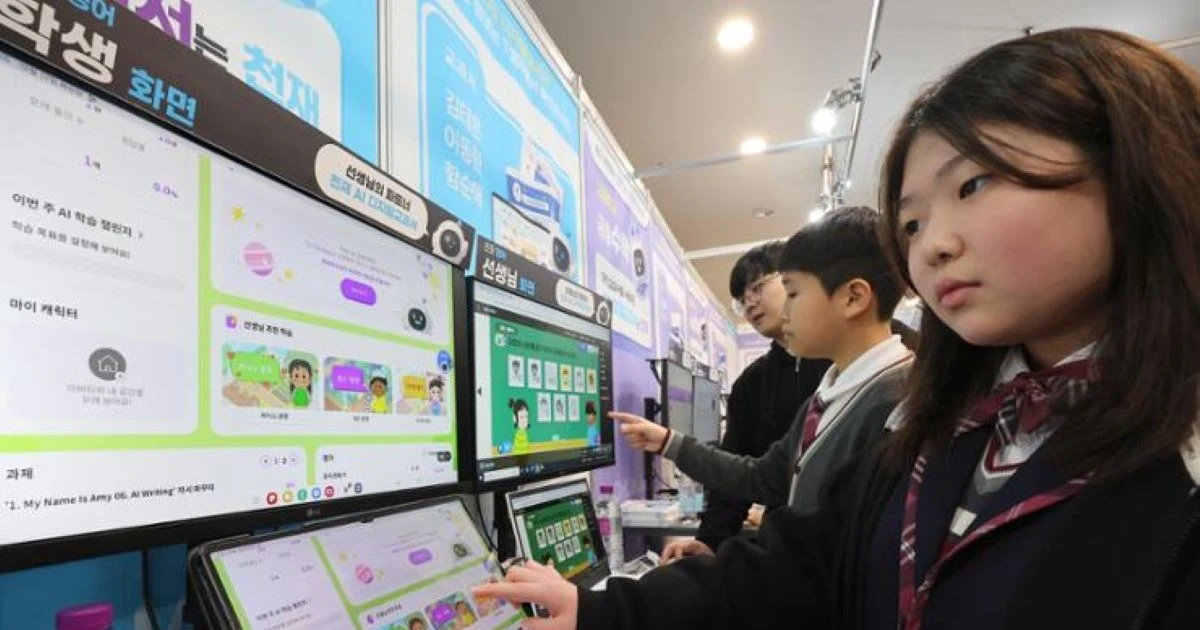Training AI: A Look Back at the Collapse of South Korea’s AI Textbook Program

The Urgency and Complexity of Educational Innovation
The Promise and the Unexpected Failure
In the context of globalization and the 4th Industrial Revolution, Artificial Intelligence (AI) has been hailed as a solution expected to “reform” and “revolutionize” education. From the United States and Europe to Asian nations like Singapore and Vietnam, many governments are betting big on AI’s potential to personalize the learning experience, enhance teaching efficiency, and prepare students for an irreversible digital future.
However, the story of South Korea—a leading global technology powerhouse, a nation known for its swift adoption of technology, from service robots to automated care—offers a costly lesson on the complexity of educational transformation. Just four months after piloting the AI textbook program in core subjects like Math, English, and Computer Science, the Ministry of Education was forced to withdraw its decision, demoting the AI textbooks from “official textbooks” to merely “supplementary materials.”
This failure is not just an isolated incident but a large-scale test that exposed deep fissures in the policymaking process for educational technology. The core reason, as one participating teacher admitted, was “the rollout was too rushed. It should have been thoroughly tested and evaluated before mass application.” The analysis below will delve into the main factors that led to this swift collapse, from political pressure and an accelerated development process, to technical and pedagogical failures in the school environment.
Political Ambition and Massive Investment Scale
The initiative for the AI textbook program was conceived under the administration of former President Yoon Suk Yeol, clearly demonstrating the government’s ambition to assert a leading position in the digital age. The initial goal was extremely promising: to create a personalized learning environment where AI could adjust content and learning pace for each student, while also easing the administrative burden on teachers.
To realize this vision, the South Korean government committed a huge investment, spending over 1.2 trillion won (approximately $850 million USD) on purchasing necessary technology equipment and training teachers. Concurrently, private publishers also participated with an estimated investment of 800 billion won ($567 million USD) to compile and develop AI-integrated digital textbook content. In total, this was a multi-billion dollar project, placing a huge bet on public-private partnership and the ability to transform national education.
The determination and strong financial resources are undeniable. However, it was the sheer scale and the pressure for rapid results (especially within a political term) that created a high-risk development environment, where urgency overshadowed prudence and meticulous review.
The Tragedy of the Accelerated Schedule: “Rushing” is the Fundamental Pedagogical Error
The most prominent factor, and arguably the leading cause of the failure, was the dizzying pace of the program’s implementation. Education is a field that demands stability, continuity, and rigorous verification processes, but the AI program did the opposite.
Female National Assembly member Kang Kyung-sook highlighted this absurdity during a parliamentary questioning: “A regular printed textbook requires 18 months for compilation, 9 months for review, and 6 months for preparation for publication. In contrast, the AI textbook only took 12 months for compilation, 3 months for review, and 3 months for preparation for publication. Why the rush?”
Analysis of the Accelerated Process:
- Compilation (12 months vs. 18 months): AI textbooks are not merely about converting print content to digital; they require the development of personalized learning algorithms, user-friendly user interfaces (UI/UX), and the integration of a vast library of learning resources. Cutting 6 months from the development of such a complex product almost guaranteed that the quality of the content would be compromised, lacking synchronization and rigorous bug testing.
- Review/Vetting (3 months vs. 9 months): The review stage is the most critical for ensuring the accuracy, pedagogical soundness, and cultural appropriateness of the materials. Reducing the review time from 9 months to 3 months suggests that the Ministry of Education either skipped or superficially executed necessary quality assessment steps. This is where risks of content errors (bugs) and mismatch in proficiency levels were predictable.
- Preparation for Publication (3 months vs. 6 months): This phase includes teacher training, preparing technical infrastructure at schools (Wi-Fi, tablets, Learning Management Systems – LMS), and widespread notification to parents. Halving this time led to severe inadequacies in preparation, especially in training teachers—the ultimate determinants of the success or failure of any new educational program.
Technical and Pedagogical Failures in the Classroom
When the official AI textbooks were implemented in March, the excitement quickly gave way to disappointment. The problems that arose were not only technical but also touched the core of the learning experience.
1. Technical Disruptions and User Burden (Students/Teachers)
Student Ko Ho-dam in Jeju Island summarized the experience: “Many classes were interrupted due to technical errors. I didn’t know how to use the new tools and had to teach myself on the computer, which made it hard to focus.”
- Technical Glitches: Disruptions due to technical errors are the clearest evidence of insufficiently tested products. System failures, unstable connectivity, or software issues can completely destroy user trust and slow down learning progress.
- Cognitive Load: Instead of focusing on the subject content (Math, English), students had to “teach themselves how to use the new tools.” This increased cognitive load, turning the technology from a supportive tool into a barrier, making it difficult for students to concentrate on the main learning objective.
2. Mismatch Between Content and Proficiency Level
Ko Ho-dam also stated: “The content of the textbook was not suitable for my level.” This is a severe failure for a program advertised as “personalized.” If the AI cannot deliver personalized proficiency levels, it is simply a poor-quality electronic textbook. This suggests that the AI algorithm or the developed learning resource repository was neither deep enough, broad enough, nor thoroughly tested for compatibility with various student groups.
3. Difficulty in Classroom Management (Teacher Feedback)
Math teacher Lee Hyun-joon in Pyeongtaek City shared: “It was very difficult to track students’ learning progress when using the AI textbook. The content quality was low, and it seemed the program was rushed.”
AI should have provided detailed, instantaneous analytics on each student’s performance (dashboard) so that teachers could intervene promptly. The fact that teachers struggled to track progress indicates that the management interface (dashboard) was ineffective, or the data collection and display system were flawed, nullifying the core benefit of the technology.
Ignored Warnings and the Erosion of Trust (Lack of Consensus)
Even when the plan was first announced, the AI program faced a wave of strong opposition from civil society organizations, parents, and teachers.
1. Risks to Data and School Health
Civil society organizations filed protests, emphasizing unaddressed risks, including:
- Personal Data Leakage: Although publishers later asserted compliance with privacy regulations and stated they did not store personal data, the initial concern about large-scale collection of student data remained a significant psychological barrier.
- Negative Impact on Pedagogy: The concern that “more screen time could weaken students’ reading comprehension and communication skills” was a serious warning. Education is not just about imparting knowledge but also about developing social skills and critical thinking through face-to-face interaction. Over-reliance on technology could inadvertently undermine these crucial soft skills.
2. Continuous Policy Changes Undermining Trust
The program’s implementation process is a prime example of policy inconsistency, eroding the trust of all stakeholders:
- Initially: The program was considered mandatory.
- January: Due to the wave of opposition, the program was shifted to a voluntary one-year pilot.
- March: AI textbooks were piloted in the first semester, achieving an adoption rate of 37% of schools.
- August: After President Lee Jae-myung took office and conducted a review, AI textbooks were withdrawn from the list of official textbooks, becoming “supplementary materials,” dependent on the decision of individual schools.
This rapid change, from mandatory to voluntary then demoted, not only caused chaos in teaching but also created confusion. Mr. Kim Cha-myung, an elementary school teacher who appreciated the benefits of AI textbooks, had to admit: “The government’s abrupt cessation of the program not only affects teaching and learning but also shakes the trust of teachers and students.” This lost trust will be the biggest obstacle to any future technology innovation efforts.
Economic Consequences and the Lesson of Spontaneity
The sudden halt of the program not only caused pedagogical harm but also led to severe economic consequences.
1. Investment Risk for Private Enterprises
Mr. Hwang Geun-sik, Chairman of the Textbook Development Committee, representing the publishers who invested 800 billion won, expressed his indignation: “Companies trusted the government and invested heavily, but the market disappeared overnight?”
Businesses poured money into content development, platforms, and copyrights. The government’s sudden change in status rendered this investment meaningless, leading to the risk of lawsuits seeking compensation at the Constitutional Court. This sets a bad precedent, making technology companies hesitant to cooperate with the government on subsequent large-scale education projects.
2. The Necessity of Standardized Testing Roadmaps
PhD Candidate Lee Bohm from Cambridge University, a former policy advisor to the Seoul Metropolitan Office of Education, offered sensible advice that came too late: “AI should be tested first in exercises or specific practical activities before being introduced into classroom instruction. The important thing is to find a reasonable way to combine technology and the curriculum.”
The lesson here is that the digital transformation in education must be evolutionary, not revolutionary. It must begin with:
- Small-Scale Pilot: Application in a limited number of schools, collecting in-depth data and feedback from teachers and students.
- Pedagogical Evaluation: Ensuring that AI genuinely improves learning outcomes, rather than just being a flashy tool.
- In-depth Training (Teacher Training): Teachers need to be trained not only on technical usage but also on how to integrate AI into existing teaching methods.
Bypassing the official testing phase and immediately applying it to the core curriculum was a fundamental mistake.
Vision and Prudence
The tragedy of South Korea’s AI textbook program is a costly warning to every nation pursuing technology-driven educational reform.
The reasons why the program failed after just four months can be summarized into four key points:
- Political Urgency: The pressure for rapid implementation led to the shortening of the compilation and review processes, sacrificing content quality and technical stability.
- Lack of Piloting: Bypassing the rigorous testing phase caused fundamental technical and pedagogical issues to erupt simultaneously during mass application.
- Lack of Consensus: The plan lacked agreement from stakeholders, especially teachers and parents, along with concerns about data and school health.
- Policy Chaos: The continuous changes in application status (from mandatory to voluntary, then demoted) eroded trust and caused economic damage to investors.
Ultimately, despite positive views on the potential of AI textbooks (such as reducing teacher workload and gamification features), even supporters agreed that the problem lay in the implementation process. AI cannot be a solution imposed from the top down; it must be a collaboratively developed tool, based on evidence and pedagogical prudence.
South Korea failed to introduce AI into education in a revolutionary manner, but their story offers a critical lesson: The path to effective AI education must be an evolutionary one—slow, built on a foundation of trust, meticulous verification, and above all, prioritizing the learning experience and the preparation of teachers.

